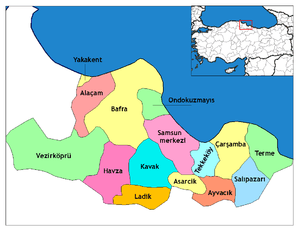Vezirköprü
| Vezirköprü | |
|---|---|
| Town | |
 Vezirköprü Location of Vezirköprü | |
| Coordinates: 41°09′00″N 35°27′01″E / 41.15000°N 35.45028°ECoordinates: 41°09′00″N 35°27′01″E / 41.15000°N 35.45028°E | |
| Country |
|
| Region | Black Sea |
| Province | Samsun Province |
| Government | |
| • Mayor | İbrahim Sadık Edis (AKP) |
| Area[1] | |
| • District | 1,799.65 km2 (694.85 sq mi) |
| Population (2012)[2] | |
| • Urban | 28,807 |
| • District | 102,212 |
| • District density | 57/km2 (150/sq mi) |
| Time zone | UTC+2 (EET) |
| • Summer (DST) | UTC+3 (EEST) |
| Postal code | 55900 |
| Area code(s) | (0090)+ 362 |
| Vehicle registration | 55 |
Vezirköprü is a district of Samsun Province of Turkey.
History
At the breakup of Alexander the Great's empire the Vezirköprü region became part of the kingdom of Pontus with its capital at Amaseia (Amasya), later at Sinope (Sinop). When the last king Mithradates VI was defeated by the Romans, Pompey the Great founded a "new city", Neapolis (Greek: Νεάπολις), which later changed its name to Neoklaudioupolis (Greek: Νεοκλαυδιούπολις) or Neoclaudiopolis in Latin, the forerunner of modern Vezirköprü. In late antiquity, the town returned to its original name, Andrapa, and became a bishopric.
Its bishop Paralius was at the Council of Ephesus (431) and sent his deacon Eucharius to represent him at the Council of Chalcedon (451). Paulus was one of the signatories of the letter by which the bishops of the Roman province of Helenopontus, to which Andrapa belonged, protested to Byzantine Emperor Leo I the Thracian in 458 about the killing of Proterius of Alexandria. Ioannes was at the Third Council of Constantinople (680), Sergius at the Trullan Council (692). Theodorus was represented at the Second Council of Nicaea (787) by his deacon Marinus. Antonius took part in the Photian Council of Constantinople (879).[3][4]
No longer a residential bishopric, Andrapa is today listed by the Catholic Church as a titular see.[5]
Administrative structure
Municipalities
Villages
- Adatepe
- Ağcaalan
- Ağcayazı
- Ahmetbaba
- Akören
- Alanbaşı
- Alancık
- Alanköy
- Alanşeyhi
- Altınkaya
- Arıca
- Avdan
- Aydınlı
- Aydoğdu
- Ayvalı
- Bahçekonak
- Bahçesaray
- Bakla
- Başalan
- Başfakı
- Bayramköy
- Bektaş
- Belalan
- Beşpınar
- Boğaköy
- Boğazkoru
- Boruk
- Burhaniye
- Büyükkale
- Cebeli
- Çakırtaş
- Çalköy
- Çalman
- Çaltı
- Çamlıca
- Çamlıkonak
- Çekalan
- Çekmeden
- Çeltek
- Çorakdere
- Danabaş
- Darıçay
- Darıçayalanı
- Devalan
- Doyran
- Duruçay
- Elaldı
- Elbeyi
- Elmalı
- Esen
- Esentepe
- Esenyurt
- Göllüalan
- Gömlekhisar
- Güder
- Güldere
- Habipfakı
- Hacılı
- Halilbaba
- Halkahavlı
- Hayranlı
- İmircik
- İncesu
- İnkaya
- Kabalı
- Kadıçayırı
- Kadıoğlu
- Kapaklı
- Kapaklıçeşme
- Kaplancık
- Karabük
- Karacaören
- Karadoruk
- Karaköy
- Karanar
- Karapınar
- Karkucak
- Karlı
- Kavakpınarı
- Kılıçgüney
- Kıranalan
- Kıratbükü
- Kırma
- Kızılcakoru
- Kızılcaören
- Kızılkese
- Kocakaya
- Kovalı
- Köprübaşı
- Kumral
- Kuruçay
- Kuşçular
- Kuyaş
- Kuyumcu
- Küçükkale
- Kületek
- Mahmatlı
- Melikli
- Meşeli
- Mezraa
- Ortaköy
- Oruç
- Ovacık
- Oymaağaç
- Öğürlü
- Örencik
- Özyörük
- Paşaköy
- Pazarcı
- Samukalan
- Samur
- Saraycık
- Sarıalan
- Sarıdibek
- Sarıyar
- Sırbaşmak
- Sofular
- Soğucak
- Susuz
- Şentepe
- Tahtaköprü
- Taşlıyük
- Tatarkale
- Teberük
- Tekkekıranı
- Tepeören
- Türkmen
- Yağcı
- Yağınözü
- Yarbaşı
- Yeniçelik
- Yenidüzce
- Yeşiltepe
- Yolpınar
- Yukarınarlı
- Yurtdağı
- Yürükçal
References
- ↑ "Area of regions (including lakes), km²". Regional Statistics Database. Turkish Statistical Institute. 2002. Retrieved 2013-03-05.
- ↑ "Population of province/district centers and towns/villages by districts - 2012". Address Based Population Registration System (ABPRS) Database. Turkish Statistical Institute. Retrieved 2013-02-27.
- ↑ Michel Lequien, Oriens christianus in quatuor Patriarchatus digestus, Paris 1740, Vol. I, coll. 539-540
- ↑ Sophrone Pétridès, v. Andrapa, in Dictionnaire d'Histoire et de Géographie ecclésiastiques, vol. II, Paris 1914, coll. 1597-1598
- ↑ Annuario Pontificio 2013 (Libreria Editrice Vaticana 2013 ISBN 978-88-209-9070-1), p. 833
Literature
- Arslan, A; İğci, N; Kıvrak, B (2008). Geçmişten Günümüze Vezirköprü (in Turkish). Vezirköprü.
- Bekker-Nielsen, Tønnes (26 November 2013). Yalcin, Ünsal, ed. "Neapolis-Neoklaudiopolis: a Roman city in northern Anatolia". Anatolian Metal IV. Der Anschnitt. Bochum: German Mining Museum. Supplement 25: 203–214. ISBN 978-3-937203-67-6. ISSN 0003-5238. Retrieved 18 January 2014.
- Bekker-Nielsen, Tønnes (28 October 2013). "350 Years of Research on Neoklaudiopolis (Vezirköprü)". Orbis Terrarum. University of Southern Denmark. 11: 3–31. ISSN 1385-285X. Retrieved 18 January 2014.
- Bekker-Nielsen, Tønnes; Høgel, Christian (2013). "Three epitaphs from the Vezirköprü region". Epigraphica Anatolica. 45. University of Southern Denmark: 153–160. ISSN 0174-6545. Retrieved 18 January 2014.
- Bekker-Nielsen, T., R. Czichon, C. Høgel, B. Kıvrak, J.M. Madsen, V. Sauer, S.L. Sørensen & K. Winther-Jacobsen 2015. Ancient Neoklaudiopolis (Vezirköprü in Samsun Province): A Historical and Archaeological Guide. Istanbul: Arkeoloji ve Sanat Yayınları.
External links
- Vezirköprü Information Page
- Vezirköprü Municipality
- Vezirköprü Facebook FanPage
- University of Southern Denmark
